#Implementation: After designing the system
Explore tagged Tumblr posts
Note
Hm ok what's your favorite or a really cool worlbuilding thing you've done? For any fandom or original or even an unimplemented idea
Hmm well at least in the past decade, my big worldbuilding projects have mostly come down to three-ish stories: Other Side of the Gun, Adventures of Gæilo and Ethon, and Just Desserts
OSG was an Invader ZiM fancomic concept I started around 2013 to justify every single Irken headcanon I ever came up with lol - I never finished it, or even really started it, but I put a lot of time and energy into its roughs back in the day :)
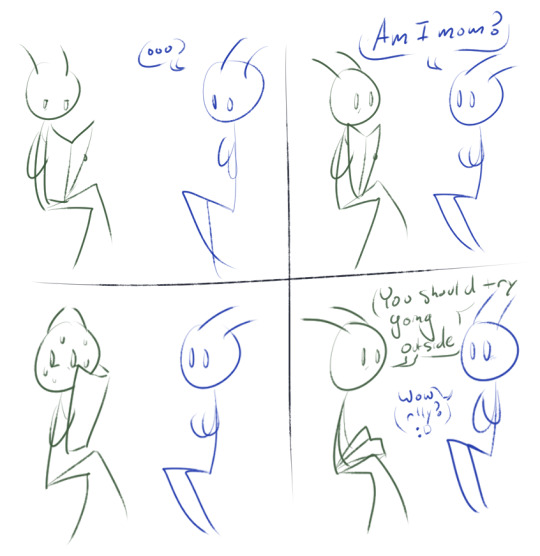
^A stick figure recap of Ch. 1, inspired by - what else - the Vargas stick figure recaps lol
One that you can see over here is all the work I did for my DnD campaign, AGE! (Though its sideblog hasn't been updated in a while haha - the AGE tag over here works just as well) I basically homebrewed a pantheon and had an absolute blast designing all the gods and their forms before they became gods and even things like architectural differences in their churches and the BBEG and his motivations and just ah <3 Such a fun project :D
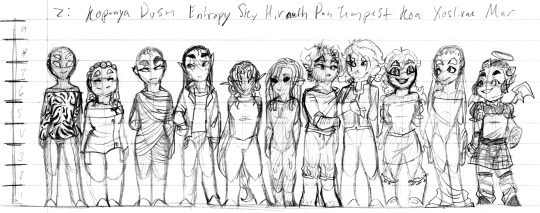
It also laid the groundwork for things like Pokemon Homestyle, specifically all my papercrafts! You can really see how I leveled up haha
And my latest has been Just Desserts! Even with less time under its belt, it's still pretty expansive, as evidenced by my icon and theme and the backlog lol, and it's the one I have the most AUs of! (Though OSG does come close actually haha) There are still some thorny details I'm trying to iron out, especially to do with the magic system, but all the characters and creatures and the fact that I made my own fighting minigame, ah, pleased! I've never been so happy with a sona before Charm! ♥ From the very beginning it's been so fun to work on and I still want to improve!
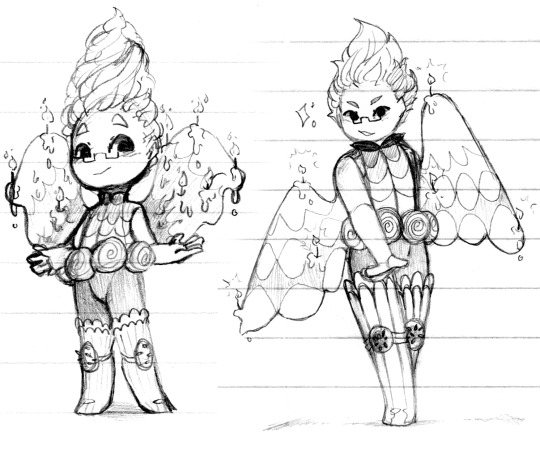
#Long post#There have been others of course - things like BunBonBop and TMatM and quite a handful of original species lol#I was also involved in an IZRP that got very in depth which is where Bar comes from actually!#As well as my brief stint into being a TGWDLM askblog lol soz to everyone over there ouq#And little stories like Karera no Kotogara and Yanderapy but those mostly set in cartoon-reality y'know?#No magic or sci fi there haha#Man looking back through the OSG stuff kinda makes me wanna unstore Ch. 0 - I've grown a lot since then!#To the point where it almost doesn't feel ''mine'' anymore haha - it has been almost ten years! Maybe to celebrate its anniversary :)#Also yeah if you look hard enough I've been in love with and inspired by Vargas for as long as I've known about it haha#AGE was so much fun <3 I would like to get back to it someday but picking back up after so long is hard!#I still hold all of them fondly of course ♥ Mar especially since they were the tipping point for me loving spiders :D#It's hard to believe Just Desserts is already four years deep! It still feels so new to me haha#I know I big up Charm and her design a lot lol but for me it really is exactly what I want <3 It's my perfect :)#I still really want to get into 3D modeling to make her as I originally envisioned her!#If I had the funds I'd absolutely commission someone but tbh I don't know many names on that side of art haha#I've also heard about people who give advice/brainstorming sessions for magic systems and I've been intrigued ever since :0#I'd love to sit down with someone and hash out Exactly how their magic works! It feels like it just needs a few more pushes!#Then again that's what I said about the TVAU outfits too haha ♪ Maybe it would all fall into place!#To the base question tho: I never know how to qualify ''implemented'' - does just putting it out there as a concept count?#Writing a story? Making a comic? A series? Polished? Completed?? Where's the line haha#I'm always so full of ideas but focusing on anything long enough to make it ''pretty'' is so hard for me still#I just keep creating never stopping haha
9 notes
·
View notes
Text
"Doctors have begun trialling the world’s first mRNA lung cancer vaccine in patients, as experts hailed its “groundbreaking” potential to save thousands of lives.
Lung cancer is the world’s leading cause of cancer death, accounting for about 1.8m deaths every year. Survival rates in those with advanced forms of the disease, where tumours have spread, are particularly poor.
Now experts are testing a new jab that instructs the body to hunt down and kill cancer cells – then prevents them ever coming back. Known as BNT116 and made by BioNTech, the vaccine is designed to treat non-small cell lung cancer (NSCLC), the most common form of the disease.
The phase 1 clinical trial, the first human study of BNT116, has launched across 34 research sites in seven countries: the UK, US, Germany, Hungary, Poland, Spain and Turkey.
The UK has six sites, located in England and Wales, with the first UK patient to receive the vaccine having their initial dose on Tuesday [August 20, 2024].
Overall, about 130 patients – from early-stage before surgery or radiotherapy, to late-stage disease or recurrent cancer – will be enrolled to have the jab alongside immunotherapy. About 20 will be from the UK.
The jab uses messenger RNA (mRNA), similar to Covid-19 vaccines, and works by presenting the immune system with tumour markers from NSCLC to prime the body to fight cancer cells expressing these markers.
The aim is to strengthen a person’s immune response to cancer while leaving healthy cells untouched, unlike chemotherapy.
“We are now entering this very exciting new era of mRNA-based immunotherapy clinical trials to investigate the treatment of lung cancer,” said Prof Siow Ming Lee, a consultant medical oncologist at University College London hospitals NHS foundation trust (UCLH), which is leading the trial in the UK.
“It’s simple to deliver, and you can select specific antigens in the cancer cell, and then you target them. This technology is the next big phase of cancer treatment.”
Janusz Racz, 67, from London, was the first person to have the vaccine in the UK. He was diagnosed in May and soon after started chemotherapy and radiotherapy.
The scientist, who specialises in AI, said his profession inspired him to take part in the trial. “I am a scientist too, and I understand that the progress of science – especially in medicine – lies in people agreeing to be involved in such investigations,” he said...
“And also, I can be a part of the team that can provide proof of concept for this new methodology, and the faster it would be implemented across the world, more people will be saved.”
Racz received six consecutive injections five minutes apart over 30 minutes at the National Institute for Health Research UCLH Clinical Research Facility on Tuesday.
Each jab contained different RNA strands. He will get the vaccine every week for six consecutive weeks, and then every three weeks for 54 weeks.
Lee said: “We hope adding this additional treatment will stop the cancer coming back because a lot of time for lung cancer patients, even after surgery and radiation, it does come back.” ...
“We hope to go on to phase 2, phase 3, and then hope it becomes standard of care worldwide and saves lots of lung cancer patients.”
The Guardian revealed in May that thousands of patients in England were to be fast-tracked into groundbreaking trials of cancer vaccines in a revolutionary world-first NHS “matchmaking” scheme to save lives.
Under the scheme, patients who meet the eligibility criteria will gain access to clinical trials for the vaccines that experts say represent a new dawn in cancer treatment."
-via The Guardian, May 30, 2024
#cw cancer#cancer research#cancer#lung cancer#nhs#england#vaccine#cancer vaccines#public health#medical news#good news#hope
1K notes
·
View notes
Text
As I prepare my own post about Terzo’s facepaint and the artist influences behind it, the Gonstfm beautiful podcast episode about the Meliora era costumes revealed some amazing insights about Terzo’s look:
The mask Terzo debuted with wasn’t exactly the wrong mask. At the time of his first show, the team hadn’t finalized the design of his face paint, and that mask wasn’t even his first one. During the Summoning video where he is introduced, we only see Terzo’s silhouette in the darkness, but in truth, he did have a mask on, and it was this one:
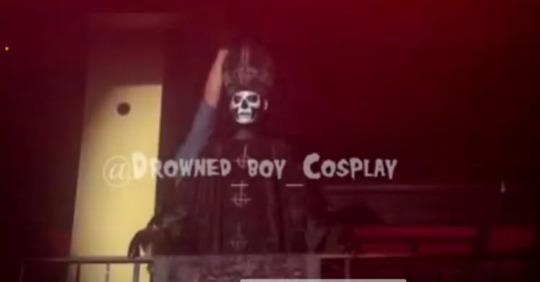
x
His white and gold suit in He Is was actually a “bullfighter” costume bought on Amazon.
The mask Terzo wore in He Is was already badly damaged at the time of the video shoot, but they used it anyway because there was no point in creating a new one, since Terzo was about to be “retired” shortly after. The damage was caused by the support system Tobias used to keep the mask in place, combined with frequent use. However, the mask later underwent an expensive restoration and was sold to a fan, who now keeps it displayed in his home. To this day, it remains the only Papa mask that has been well preserved.
The uncanny, unpainted mask in the Back on the Road chapter: no real effort was put into that mask. It was simply a mask that “was there”. They slapped on some eyebrows, added hair with the wrong hairline, and put it on someone who didn’t fit in.
The infamous ball-fight during From the Pinnacle to the Pit was one of the reasons a change in stage outfit was implemented. After the fall, Terzo hurt his leg and reconsidered the wisdom of kicking a giant ball while wearing a full Papal costume.
I love how they emphasize that Terzo’s mask was a true work of art, with hyper-realistic details such as skin texture, wrinkles, visible pores, and even vein coloring, all created by a small local artist who, according to them, did a better job than the big mask company currently producing the masks.
#I suggest you listening to the podcast because it’s so interesting!#the band ghost#papa emeritus iii#terzo emeritus#gonstfm#Meliora#papa mask
216 notes
·
View notes
Note
Please do explain the process I'm curious
Okay okay oka
So!
First of all, I carefully went through all the designs and noticed that many elements are repeated from character to character. Many of the characters share the same arms, legs, heads, and everything. Which led me to the idea that I don't need to imagine for myself what every element of Prowl's design looked like after getting the t-cog. I just need to see how the transformation changes the components Prowl is made of.
And what do you think - almost all of the parts Prowl is made of are found in other characters>:D
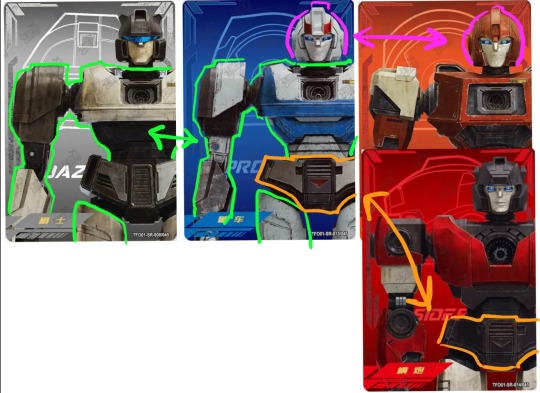
Next, all I need to do is look at how the transformation changed these pieces. And build Prowl's basic pieces out of them like a construction kit.
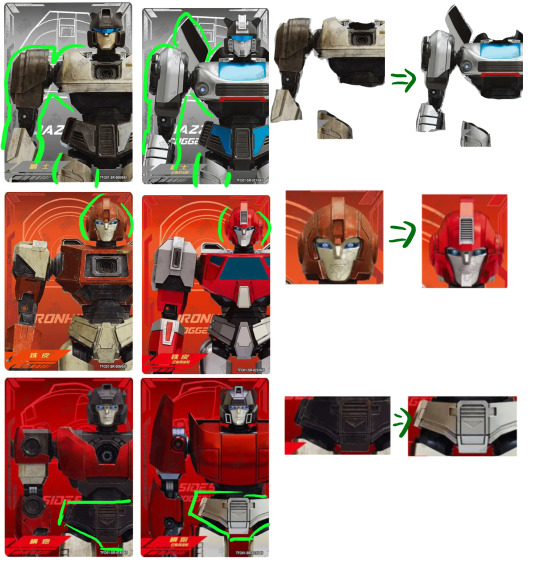
Now coloring is a tricky part.
It doesn't follow a clear system, but there are some vague patterns too.
The designs lean heavily on g1, so I took g1 Prowl as a basis. At the same time, those blue pieces remind me a lot of Earthspark Prowl, so he was taken as a reference too. (Transformers media always uses its own different generations as references. I figured I would better use the already existing official concept instead of my headcanons)
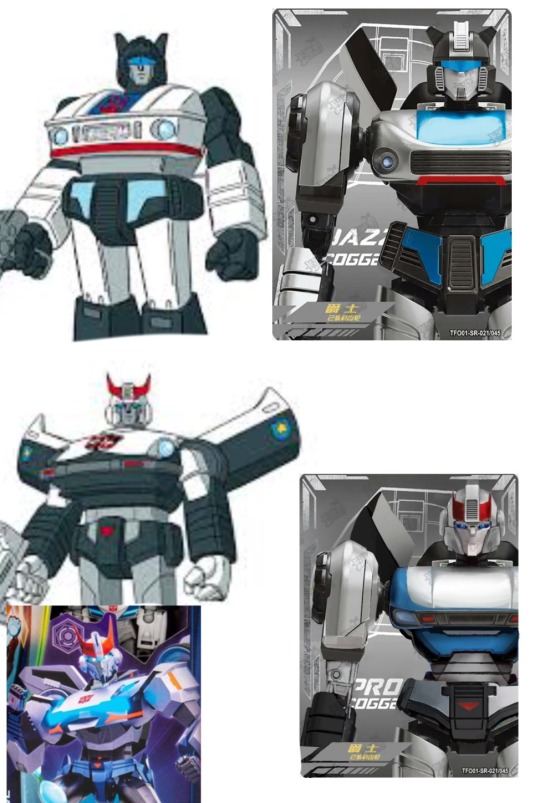
As a result. Yaaay he has doorwings~
Also ahaha yeah his chevron is still pretty small but let's face it. Tf one artstyle doesn't really allow it's characters heads to be sharp and pointy, they all are kind of rounded? I believe tf one Prowl's chevron wouldn't be big enough to change his silhouette.
So. Yeah this is it. I can assure you I tried my absolute best to avoid implementing my own vision on him and focused on matching the movie style instead. (And let me tell you haha if I designed him to look like I personality want he would look waaaay different)
#maccadam#transformers#prowl#tf one#transformers one#tf one prowl#ironhide#sideswipe#Jazz#If i designed him as I like his chevron would be like two times bigger hahah#something like es Prowl
615 notes
·
View notes
Text
now introducing the future of music and entertainment, endless options of sound (eos)

eos is an app that i script into most of my drs. i got inspired to create it after coming across a video on youtube of someone re-designing spotifys UI. i’ve used spotify, apple music, amazon music, youtube music, and many more music streaming services and none of them ever lived up to my expectations, so i thought why not create what i’ve always wanted? i took a long hard look at all of the features i wish the current apps had and put them all into one. i posted about it before on my previous account but didn’t go into the actual details much. it started as a music streaming app when it was launched but became much more than that. it’s one of my favorite parts of my drs because i’m an avid music listener and the features are to die for. eos is the only music streaming app in my drs. i also have a ceo dr where i’m the ceo of it because this app has basically become my child!!! anyways here’s what i have after working on it for months!
eos was launched on october 31, 2001 by robyn fenty (she’s older LMAO) and aliyah haughton. the app immediately gained popularity as the first and only music streaming service. it was created as a space where everyone could enjoy music. years later it implemented audiobooks, podcasts, music videos, interviews, merch, and concert tickets. it stands out with its flawless performance that never crashes or has bugs, its exceptional algorithm for fresh experiences each playtime, and its features like eosoulmates that connects users through shared music tastes.
lyrics and subtitles are always available in any language desired by the user and the platform includes organization like no other. exclusive presale codes are able for top listeners of specific artists because the app has its own ticketing system. eos is free for all users as the founders wanted to make a space to unify people during life’s challenge. to maintain this while making sure artists are fairly paid, revenue is generated through a share of concert ticket and merchandise sales, in-app donations directly supporting artists, non-intrusive sponsorships and partnerships, and grants from philanthropic organizations. this guarantees that eos stays true to making music accessible while supporting creators and users globally.
to expand on existing sounds of music and entertainment, the service implemented dolby atmos to its highest quality with no extra price to artists for using it.
eos also features eos karaoke: sing it your way. within this are lyrics that are displayed in perfect sync with customizable highlighting options, while users can adjust the original vocals (mute, reduce, or add harmonies) for a personalized performance. advanced pitch tracking gives real-time feedback, along with timing guides and a practice mode for perfecting songs. voice effects like reverb, autotune, and fun filters are available to take things to a higher level or have fun with friends and family. dual-screen mode connects to tvs for party setups and users can enjoy duets with friends or group singing for up to 10 people. karaoke playlists are curated based on mood, listening habits, or vocal range. sessions can be recorded and shared with friends or on social media. a scoring system with feedback helps users improve their singing while earning fun badges. eos karaoke also offers live virtual karaoke rooms, offline mode for downloaded tracks, and customizable themes for lyric screens and backgrounds. a special kid-friendly mode ensures the fun for all age groups.
eos allows music and entertainment to be accessible, fun, and, immersive to everyone.

#⋆ ౨ৎ ˚ ˖ dessarchive#dessa ★ scripts#reality shifting#shifting#shifting antis dni#shifting consciousness#shifting diary#shifting motivation#shiftingrealities#shifting script#scripting#shift blog#shifting realities#shifters#shifting blog#shifting community#desired reality#law of assumption#law of attraction#law of manifestation#shiftblr#kpop shifting#fame desired reality#fame shifting#fame dr#kpop dr
360 notes
·
View notes
Text
✧・゜: ✧how i use pinterest intentionally (not just endless scrolling) :・゜✧:・゜✧



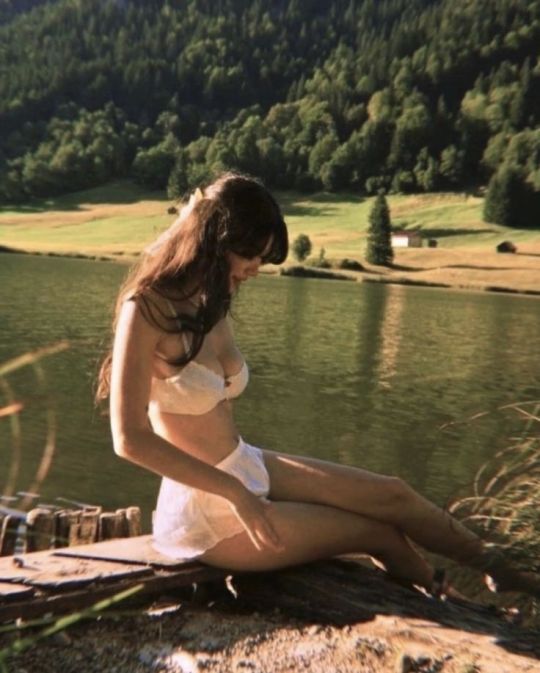

hey lovelies! ✨
confession time: i used to be a chronic pinterest scroller with absolutely nothing to show for my hours spent in the app. i'd save hundreds of pins to boards with vague names like "aesthetic" and "vibes," never to look at them again. sound familiar? but over the past year, i've completely transformed how i use pinterest from mindless consumption to an intentional tool that actually enhances my life. here's exactly how i made the shift!
⋆.ೃ࿔:・ the pinterest mindset shift ・:࿔ೃ.⋆
the game-changer for me was realizing that pinterest isn't just for collecting pretty pictures, it's a visual search engine and planning tool. now i approach it with purpose:
i ask myself "why am i opening this app right now?" before i even click the icon or enter it into the search bar
i set specific time limits for browsing (15-30 minutes max)
i focus on quality over quantity with my pins
i treat my boards as action plans, not just digital hoarding spaces
i regularly revisit and implement ideas from my boards
this shift transformed pinterest from a time-waster to one of my most valuable tools for planning, creativity, and personal growth.
⋆.ೃ࿔:・ my board organization system ・:࿔ೃ.⋆
the foundation of intentional pinterest use is thoughtful organization! here's my current system:
𝘮𝘢𝘴𝘵𝘦𝘳 𝘤𝘢𝘵𝘦𝘨𝘰𝘳𝘪𝘦𝘴: i group my boards into categories using board covers in the same color palette (lifestyle, home, fashion, etc.)
𝘢𝘤𝘵𝘪𝘰𝘯𝘢𝘣𝘭𝘦 𝘯𝘢𝘮𝘪𝘯𝘨: instead of vague names, i use specific titles like "meals for busy weeknights" or "bedroom refresh ideas 2025"
𝘴𝘦𝘤𝘵𝘪𝘰𝘯𝘴 𝘸𝘪𝘵𝘩𝘪𝘯 𝘣𝘰𝘢𝘳𝘥𝘴: i break down larger boards into sections (my "morning routine" board has sections for drinks, movement, journaling, etc.)
𝘱𝘳𝘪𝘷𝘢𝘵𝘦 𝘷𝘴. 𝘱𝘶𝘣𝘭𝘪𝘤: i keep boards private when they're in planning stages, then make them public once they're curated
𝘴𝘦𝘢𝘴𝘰𝘯𝘢𝘭 𝘢𝘳𝘤𝘩𝘪𝘷𝘪𝘯𝘨: i archive boards that aren't currently relevant (like christmas decor in july) to reduce visual clutter
⋆.ೃ࿔:・ my favorite intentional board types ・:࿔ೃ.⋆
here are the board categories that have added genuine value to my life:
𝘱𝘳𝘰𝘫𝘦𝘤𝘵-𝘴𝘱𝘦𝘤𝘪𝘧𝘪𝘤 𝘣𝘰𝘢𝘳𝘥𝘴: whenever i start a new project (room redecoration, event planning, etc.), i create a dedicated board with sections for different aspects
𝘴𝘦𝘢𝘴𝘰𝘯𝘢𝘭 𝘪𝘯𝘵𝘦𝘯𝘵𝘪𝘰𝘯 𝘣𝘰𝘢𝘳𝘥𝘴: i create a fresh board each season with sections for recipes, activities, outfits, and decor i want to incorporate
𝘤𝘢𝘱𝘴𝘶𝘭𝘦 𝘸𝘢𝘳𝘥𝘳𝘰𝘣𝘦 𝘱𝘭𝘢𝘯𝘯𝘪𝘯𝘨: i pin actual items i own alongside new pieces i'm considering to visualize combinations
𝘮𝘦𝘢𝘭 𝘱𝘭𝘢𝘯𝘯𝘪𝘯𝘨 𝘴𝘺𝘴𝘵𝘦𝘮: i maintain boards for different meal categories and actually reference them when making grocery lists
𝘨𝘪𝘧𝘵 𝘪𝘥𝘦𝘢𝘴: i have a board for each important person in my life where i pin potential gifts year-round
𝘨𝘰𝘢𝘭 𝘷𝘪𝘴𝘶𝘢𝘭𝘪𝘻𝘢𝘵𝘪𝘰𝘯: i create boards for specific goals with both inspiration and actionable steps
⋆.ೃ࿔:・ my pinterest workflow ・:࿔ೃ.⋆
this is my personal step-by-step process for intentional pinning:
𝘴𝘦𝘵 𝘢 𝘤𝘭𝘦𝘢𝘳 𝘱𝘶𝘳𝘱𝘰𝘴𝘦: i decide what specific question i'm trying to answer or problem i'm trying to solve
𝘤𝘳𝘦𝘢𝘵𝘦 𝘢 𝘴𝘦𝘢𝘳𝘤𝘩 𝘴𝘵𝘳𝘢𝘵𝘦𝘨𝘺: i use specific search terms rather than browsing the home feed (which is designed for endless scrolling)
𝘤𝘶𝘳𝘢𝘵𝘦 𝘤𝘢𝘳𝘦𝘧𝘶𝘭𝘭𝘺: i only save pins that: • provide clear value or inspiration • lead to actual content (not dead links) • represent ideas i genuinely might implement
𝘢𝘥𝘥 𝘯𝘰𝘵𝘦𝘴: i write specific notes on pins about why i saved them or how i plan to use the idea
𝘪𝘮𝘱𝘭𝘦𝘮𝘦𝘯𝘵𝘢𝘵𝘪𝘰𝘯 𝘱𝘭𝘢𝘯𝘯𝘪𝘯𝘨: after a pinning session, i schedule time to actually try one of the ideas
⋆.ೃ࿔:・ from virtual to reality ・:࿔ೃ.⋆
the most important part of intentional pinterest use is implementation! here's how i ensure my pins actually translate to real life:
𝘸𝘦𝘦𝘬𝘭𝘺 𝘱𝘪𝘯 𝘳𝘦𝘷𝘪𝘦𝘸: every sunday, i spend 10 minutes reviewing recent pins and selecting 1-3 to implement that week
𝘱𝘪𝘯-𝘵𝘰-𝘢𝘤𝘵𝘪𝘰𝘯 𝘵𝘳𝘢𝘤𝘬𝘦𝘳: i keep a simple journal noting which pins i've actually implemented
𝘱𝘩𝘰𝘵𝘰 𝘥𝘰𝘤𝘶𝘮𝘦𝘯𝘵𝘢𝘵𝘪𝘰𝘯: i take photos of my real-life versions of pinterest inspiration
𝘳𝘦𝘢𝘭𝘪𝘵𝘺 𝘤𝘩𝘦𝘤𝘬𝘴: i regularly ask "do i have the time/budget/skills for this?" before saving aspirational pins
𝘴𝘦𝘢𝘴𝘰𝘯𝘢𝘭 𝘤𝘭𝘦𝘢𝘯𝘰𝘶𝘵: i remove pins that no longer feel aligned with my taste or goals
⋆.ೃ࿔:・ advanced pinterest strategies ・:࿔ೃ.⋆
once you've mastered the basics, these strategies take intentional pinning to the next level! i hope you all enjoy them!:
𝘨𝘳𝘰𝘶𝘱 𝘣𝘰𝘢𝘳𝘥𝘴: i create collaborative boards with friends for shared projects or trips
𝘱𝘪𝘯 𝘮𝘢𝘱𝘱𝘪𝘯𝘨: for complex projects, i create flow charts showing how different pins connect to each other
𝘪𝘥𝘦𝘢 𝘦𝘷𝘰𝘭𝘶𝘵𝘪𝘰𝘯 𝘣𝘰𝘢𝘳𝘥𝘴: i document my own progress by pinning "before" and "after" images of my projects
𝘤𝘰𝘯𝘵𝘦𝘯𝘵 𝘤𝘢𝘭𝘦𝘯𝘥𝘢𝘳: i use pinterest to plan content themes for my blog and social media (i of course also use pinterest for images for my blog)
𝘭𝘦𝘢𝘳𝘯𝘪𝘯𝘨 𝘱𝘢𝘵𝘩𝘸𝘢𝘺𝘴: i create sequential boards that build skills in a particular area
⋆.ೃ࿔:・ final thoughts ・:࿔ೃ.⋆
pinterest is whatever you make of it, it can be a mindless scroll hole or one of the most powerful tools for intentional living and creativity. the difference lies entirely in how you approach it.
i still enjoy the occasional aimless browsing session (we all need that sometimes!), but transforming most of my pinterest time into purposeful searching and planning has genuinely enhanced my life. my spaces are more cohesve, my wardrobe more intentional, and my creative projects more focused, all because i stopped treating pinterest like social media and started using it like the powerful visual tool it truly is.
how do you use pinterest? are you a careful curator or a joyful browser? feel free to drop your thoughts in the notes!
xoxo, mindy 🤍

#pinterest tips#pinterest organization#pinterest aesthetic#girl tips#productivity hack#pinterest for planning#pinterest workflow#digital organization#pinterest boards#pinterest strategy#aesthetic organization#intentional living#pinterest inspo#productivity tips#pinterest guide#pinterest board ideas#pinterest hacks#aesthetic planning#pinterest tutorial#intention setting#coquette planning#aesthetic productivity#digital declutter#organization tips#pinterest board organization#girly productivity#that girl tips#pinterest sections#visual planning#digital planning
165 notes
·
View notes
Text
Talents in Navamsha
The D-9 Divisional Chart, or Navamsha Chart, is the second most important chart after the Rasi or D-1 chart. It reveals our potential and certain patterns that characterise our inner world, which typically evolve over a lifetime. With the help of the Navamsha chart, we can also identify our innate talents - these are reflected in the Trikona houses (1, 5, 9) and the planets located there. Any planet placed in one of these houses indicates capabilities and talents carried over from past lives, as well as the areas of life that are naturally preferred for one's activities.
Besides planets located in Trikona houses, it is important to analyse their placement in the Rasi (D-1) Chart, too. And of course, we need to pay attention to the signs of the Trikona houses as well as their rulers.
HOUSES IN NAVAMSHA CHART DESCRIBE...
The first house - The planets in the 1st house of the Navamsha chart reveal the skills, talents, and preferences that are inherent to a person from early childhood, essentially from birth. These often manifest as unconscious abilities, yet people still identify with them on a deep level. Interestingly, individuals may not even recognise these traits as special, assuming them to be average or ordinary simply because they come so naturally.
The fifth house - The planets in the 5th house of the Namasha chart will tell about those talents, which require some personal efforts.
The ninth house -The 9th house planets in Navamsha chart reveal the true direction, skills, and talents that help a person live in harmony with the world and fulfill their life mission.
PLANETS IN NAVAMSHA TRIKONA HOUSES (1,5,9):
Sun: bestows a gift to make an impression, inspire, manage, protect, and unite. Areas where to implement these talents: business, politics, social work, medicine and healing, protection of public order
Moon: talents in pedagogy, psychology, caregiving, the arts and writing. Areas where to implement these talents: charity, social work, childcare, artistic fields, psychology (especially in roles involving or supporting women)
Mars: natural skill in management, sports, martial arts, cooking, mechanics, electrical work, and engineering. Areas where to implement these talents: business (particularly oriented toward men, such as automotive, shipping, or barbering), restaurants, maintenance services, engineering, industrial design, and architecture.
Mercury: gives sharp intellect, eloquence, and talents in public speaking, writing, acting, teaching, and commerce. Areas where to implement these talents: business, trade, accounting, education, journalism, medicine, creative and technical writing and scientific research
Jupiter: grants innate wisdom, reason, and talent for teaching, coaching, and guiding others. Areas for applying these talents: education, writing, life coaching, psychology, medicine, law, jurisprudence, and banking.
Venus: bestows a natural talent for charm, aesthetic expression, and the ability to bring beauty into the world through art, decoration, and refinement. This placement often indicates artistic gifts in painting, music, design, and performance (dance, singing, etc.) It supports success in fields related to the beauty and entertainment industries. Areas for applying these talents: arts, sewing, beauty industry, entertainment, acting, makeup, design, and businesses aimed at or involving women.
Saturn: gives wisdom beyond one's years, natural talents in self-discipline, resilience, and endurance. It grants a strong capacity for long-term planning and working within structured systems. People with Saturn in trikona (1,5,9) houses often possess a karmic affinity for supporting the elderly or those in need of stability and care. Areas for applying these talents: social work, management, work with the elderly, construction, architecture, working with metals, building materials, antiques, or anything aged and worn that requires repair, restoration, or preservation.
Rahu:grants a broad perspective, a unique and unconventional mindset, and strong abilities in learning foreign languages and adapting to new environments. It bestows talents in psychology, entertainment, and innovative thinking. Individuals with this placement often stand out for their originality and can serve as both innovators and provocateurs, challenging norms and opening new paths. Areas for applying these talents: IT, social media, advertising, psychology, esoteric studies (including astrology), innovation-driven fields.
Ketu: grants strong intuition, deep knowledge in psychology, religion, esoteric studies (including astrology). Talents in maths, programming, IT. Afflicted Ketu can give thievish tendencies. Areas for applying these talents: psychology, IT, research, esoteric studies, hairdressing (Ketu is known for cutting abilities).

202 notes
·
View notes
Text
India’s $13.9 billion aviation industry—projected to cater to over 300 million domestically by 2030—is a ticking time bomb.
This July, in the sweltering heat at the Delhi High Court, additional solicitor general Aishwarya Bhati announced that new rules on pilot duty and rest periods would not be implemented this year after all. Introduced by the Directorate General of Civil Aviation (DGCA) in January, the rules were designed specifically to combat pilot fatigue. They were set to take effect in June, but were abruptly retracted. The hearing addressed a writ petition filed by the Federation of Indian Pilots (FIP), seeking clarity on when the new norms would be enforced. The DGCA’s response followed its request to airline companies in April for a tentative implementation timeline.
Concerns over pilot fatigue had been mounting in the months leading up to the announcement of the new Flight Duty Period, Flight Time Limitations, and Prescribed Rest Periods by the DGCA. The urgency deepened in November 2023 when a 37-year-old Air India pilot, Captain Himanil Kumar, collapsed at Delhi Airport while training to fly the airline's Boeing 777 fleet, and later died at the hospital. Kumar was the second Indian pilot to die on duty within three months; in August, Captain Manoj Subramanyam, a 40-year-old IndiGo pilot, suffered a fatal cardiac arrest just minutes before his flight from Nagpur.
These back-to-back tragedies raised alarm in the industry. “Another young Indian pilot passed away today due to a suspected cardiac event,” reportedly tweeted Captain Shakti Lumba, a retired IndiGo VP who is now the president of the Professional Pilots Society in India (His tweet was since deleted.) “If this doesn’t convince the DGCA, civil aviation ministry, and airlines to urgently address the stress, fatigue, and anxiety among pilots, nothing will.”
The DGCA, India’s aviation watchdog, regulates the country’s Flight Duty Time Limitations (FDTL). At 13 hours of flight duty time, India’s FDTL is already demanding, but after the pandemic slowdown, increased route expansion and pilot shortages have forced many to fly beyond the recommended maximum of 60 hours a week, exacerbating crew exhaustion. The DGCA finally responded to the growing crisis by revising FDTL norms in January 2024.
The new guidelines increased weekly rest periods from 36 to 48 hours and introduced quarterly fatigue reports. Its scheduled implementation on June 1, 2024, was pushed back due to pressure from operators. An airline CEO, speaking anonymously to the Economic Times in January, claimed the proposed regulations would require a 20 percent increase in pilot numbers, which would escalate expenses and lead to huge numbers of flight cancellations. Still, the DGCA held firm on the FDTL implementation deadline till early March. By the end of the month, however, it appeared to have yielded to influence from the airline lobby. A notice on the regulator’s website announced the deadline had been deferred, without providing a reason or setting a new date.
The pilot fatigue problem isn’t unique to India. In January, two pilots for Indonesia-based Batik Air fell asleep for 28 minutes mid-flight, causing their plane to veer off course between Sulawesi and Jakarta. In April, unionized Virgin Atlantic pilots in the UK voted 96 percent in favor of pursuing an industrial action in response to rising fatigue. Earlier, the CEO of Wizz Air UK faced a backlash for urging crew members to push through their fatigue to avoid flight cancellations. In May, senior pilots at Virgin Australia raised safety concerns, claiming rostering systems were pushing them "to the limits.”
But in India, the belief that overwork and fatigue are not just acceptable but essential has become entrenched across industries. The aviation crisis is just the tip of the iceberg; it is the tech industry that is leading the charge. Last year, Infosys cofounder Narayana Murthy suggested that Indian youth should work 70 hours a week for the nation's development. Murthy’s advice came up at the Indian Parliament on the first day of its winter session and found support from a list of influential Indian tech leaders, including Bhavish Aggarwal, founder of India’s first AI unicorn, Ola Krutrim; Ayushmaan Kapoor, cofounder of the AI-powered customer platform Xeno; and even veterans like Sajjan Jindal, CEO and MD of JSW Group, and Vinod Khosla of Sun Microsystems. Almost all of them justified the extended work hours, which far exceed the maximum eight to nine hours per day stipulated by the International Labour Organisation and the Indian Labour Code, as necessary for strengthening India’s economy. “We have to make India an economic superpower that we can all be proud of,” Jindal wrote on X. He cited Indian prime minister Narendra Modi, “who works 14-16 hours everyday,”as a model. In July this year, the Karnataka State IT/ITeS Employee Union said the state government had plans to increase working hours in the sector from the current maximum of 10 hours (including overtime) to a staggering 14 hours a day. As the union planned massive campaigns to oppose the move, the labor minister stated that the push for the proposal had come from the companies.
The airline companies think they have a solution to the fatigue crisis: technology. IndiGo, India’s largest airline, announced it would be an “early adopter” of a wrist-worn fatigue-monitoring device it was developing with French defense and aerospace company Thales Group. The device can provide “detailed insights into demographic data, including routes, pairings, crew profiles, and more, going beyond traditional scheduling-focused biomathematical models,” the airline stated in a press release in September. The airline, which operates 2,000 flights daily and employs over 5,000 pilots, said the device would be rolled out after a proof-of-concept trial. No date for the rollout was announced.
Wearable activity trackers are not new to the aviation industry. IndiGo’s device sounds similar to Actiwatch, a now-discontinued line of research-grade actigraphs from Philips, used to monitor sleep patterns, study circadian rhythms, and track physical activity as part of an airline’s fatigue risk-management system. But they partly rely on performance tests and subjective measures, such as self-reporting, which often results in being targeted by the airlines, says Captain C. S. Randhawa, president of the Federation of Indian Pilots. Safety management systems on the whole tend to be neglected by operators and are viewed as an additional expense, says Captain Amit Singh of the NGO Safety Matters Foundation.
In May 2023, Air India launched safety management software called Coruson, as well as BAM (Boeing Alertness Model), a fatigue-mitigation tool integrated into its rostering system, which is used by airlines to create and manage pilot schedules. Coruson, developed by cloud software company Ideagen, centralizes, analyzes, and reports on safety-related data—such as incidents, hazards, and risk assessments. BAM, developed jointly by Boeing and the software company Jeppesen, predicts and manages pilot fatigue by analyzing flight schedules and performance data. These tools were designed to prevent the creation of fatiguing rosters and pairings, Air India CEO Campbell Wilson noted in an internal message to employees. The carrier also introduced two new digital tools for its crew—the Pilot Sector Report app, to help pilots easily submit information on flight performance, incidents, and observations post-flight; and DocuNet, a digital management system that facilitates the storage, retrieval, and sharing of documents (such as flight manuals, training records, and compliance documents).
Despite these measures, the airline was fined by the DGCA in March this year for violating FDTL limits and fatigue management rules. This May, Air India Express cabin staff called in sick en masse to protest against “mismanagement.” This followed a similar protest from the crew, mostly pilots, at Vistara airlines. Both Air India and Vistara are now owned by one of India’s largest conglomerates, the Tata Group, which took over the former from the Indian government in January 2022.
Twenty-five of those who called in sick at Air India Express were terminated. Others were reportedly served an ultimatum. Those sacked were later reinstated by the airline following an intervention by the chief labour commissioner. Nearly a week before, the regional labor commissioner of Delhi had allegedly written to the Tata group chairman pointing to “blatant violations of labour laws” and insisting the legitimate concerns of the cabin crew be looked into. According to CNBC, Vistara employees said the agitation at their end had to do with recent salary updates, which fixed pilot pay at 40 flight hours—down from 70. Protesting first officers claimed that the new salary structure would result in an almost 57 percent pay cut. Under the new terms they would also have to fly up to 76 hours to earn what they were previously earning at 70 hours.
To placate the pilots and get them back to work, management had assured them that salaries for the “extra working hours” would be credited once Vistara was integrated with Air India. At the time, two Air India pilots unions had written to the chairman of the company, saying that such issues were not isolated but systemic. Burnout was the other related issue, with many pilots complaining of inadequate rest and being pushed to their limits.
Captain Singh, a former senior manager at AirAsia, tells WIRED that such effects significantly increase the risk of accidents, but also adversely affect pilot health in the long run. Tail swaps—rushing between different types of aircraft to take off immediately after disembarking from another—have become more prevalent under the 13-hour rules, and can further contribute to exhaustion, as do hasty acclimatization and, most significantly, landing three, four, or more flights consecutively, which Captain Randhawa described as a “severe energy management challenge.”
In the 2024 “Safety Culture Survey” conducted by Singh’s Safety Matters Foundation in July, 81 percent of 530 respondents, primarily medium- to short-haul pilots, stated that bufferless rosters contribute to their fatigue. As many as 84 percent indicated concerns with the speed and direction of shift rotation. “That’s the problem with the new rostering softwares the operators are introducing,” a pilot from a private airline, who requested anonymity, says. “They’re optimizers designed to make pilots work every second of their 13-hour schedule, leaving no breathing room.” The buffer-deficient timetables push pilots to their limits, so any additional pressure—like unpredictable weather—can easily overwhelm them.
Solving this issue with wrist-worn fatigue-measuring devices is contentious. But that isn’t the only problem. A year since they were hyped up, the buzz around fatigue-management tech has all but fizzled out. There have been no updates from IndiGo about the wrist device. Neither IndiGo nor the Thales Group responded to requests to comment.
589 notes
·
View notes
Text
The Jerusalem Post said the maritime corridor plan was Prime Minister Benjamin Netanyahu’s idea, citing an unnamed “senior diplomatic source.” Netanyahu had reportedly first proposed the plan to Biden in October, and pressed the issue again with the US president in January.“ This source, close to the prime minister, insinuated that Biden was simply implementing a plan by Netanyahu, not actually initiating anything new,” the Post reported. While touring Gaza’s coast in a naval vessel on Sunday, Israeli defense minister Yoav Gallant expressed enthusiasm about the plans of a maritime corridor. “The process is designed to bring aid directly to the residents and thus continue the collapse of Hamas’s rule in Gaza,” he said.
But why would Israel, the engineer of the Gaza famine, endorse the idea of establishing a maritime corridor for aid to address a crisis it initiated and is now worsening? This might appear paradoxical if one were to assume that the primary aim of the maritime corridor is to deliver aid.Palestinians in Gaza received the news about the planned port with fear and suspicion. Analysts have speculated that this could be a ploy to eliminate Egypt as an outlet between the Gaza Strip and the rest of the world, and sever the coastal enclave’s reliance on Egypt economically and politically by way of the Egyptian-controlled Rafah crossing – the sole point of exit and entry for most people in Gaza. This would ostensibly complete Israel’s control of the Gaza Strip without dependence on Egyptian cooperation, reliable as it may have been. Abdel Bari Atwan, a Gaza-born world-renowned Palestinian journalist, invoked the US-facilitated evacuation of thousands of Palestinian guerilla fighters of the Palestine Liberation Organization from Beirut in 1982 as an insight into what these plans could possibly suggest. Palestinian fighters were transferred by US warships off the Beirut coast to Cyprus and eventually to Tunisia. Atwan indicated that the maritime corridor would create a pathway for the forcible evacuation of Palestinians by sea. Other analysts have expressed similar fears.
Michael Fakhri, the UN special rapporteur on the right to food, slammed what he called “absurd” US plans for getting aid into Gaza, whether through airdrops or the temporary port. “From a humanitarian perspective, from an international perspective, from a human rights perspective, it is absurd in a dark, cynical way,” he said. Human rights groups have dismissed announcements of building a temporary pier as a distraction from Israel’s systemic and deliberate policy of starvation of Palestinians in Gaza. “The proposed maritime humanitarian corridor and temporary seaport is another tool to weaponize aid,” the Palestinian refugee advocacy group Badil said. It is meant to “absolve Israel of its responsibilities and obligations, and support Israel in its ‘day after plans’: to eliminate and replace UNRWA [the UN agency for Palestine refugees] and establish a potential mechanism for Palestinian forcible transfer out of the Gaza Strip.”
#yemen#jerusalem#tel aviv#current events#palestine#free palestine#gaza#free gaza#news on gaza#palestine news#news update#war news#war on gaza#famine#genocide#gaza genocide#politics#end the occupation
1K notes
·
View notes
Text

"Mind stopping for a quick check before class?"
I've been rewatching Kill La Kill and remembered an old concept I had stored away from last year. That one got scrapped ages ago for being hard to write, so I started on a clean slate for this one. I think if submas were at Honnōji Academy, they'd either be engineering tech for the cable car system linked to the school or they'd work in the disciplinary committee to look after students.
I'm still roughing some details out for this but basically their job is to catch all the students who get absolutely bodied during the plot and run them back to the infirmary so they can come in the next day. When there aren't big fight scenes to deal with, they mostly just patrol the halls to check on students and make sure people aren't hurting each other during school hours. Consider them student health and welfare agents I suppose. They do straightforward work and were granted two star goku uniforms to make sure they had the speed and strength necessary to carry and treat students in a timely manner. Can't have an active student body if it takes weeks to get through patching them all, right?
Anyways I might design a powered up form for these guys later. It likely wouldn't be much different, but it'd be something light for them to operate in. No room for accessories when you're resetting bones and dressing up burns; I might consider having their hats swap out for masks and wide collars for lab coat lapels. It'd be fun to have their enforcement tools get turned into medical/surgical implements too, though that's gonna take some testing.
Bonus time: someone asked for oil. Do not oil them.

Have a good day.
#submas#submas au#kill la kill#klk#kill la kill au#au#fanart#klk fanart#ingo#subway master ingo#ingo pokemon#nobori#emmet#subway master emmet#emmet pokemon#kudari#crossover#goku uniform#The story reason they still have their massive coats and hats is to make them easy to spot in a crowd if someone needs assistance#They're nice if nothing else‚ though there's only so much welfare service they can do with the academy hierarchy#I'd imagine they transferred in either from overseas or just from a different city in Japan‚ so they aren't happy about it either#Also if it isn't clear: they are students‚ aged around 17-18 in third year. They just help out in the infirmary and with monitoring
195 notes
·
View notes
Text

YOU'VE ACTIVATED MY TRAP CARD [excuse to talk]
Everyone strap in because while I talk about a lot of queer issues this is actually my biggest beefiest thing that I am personally passionate about.
I. Copyright Abolishment: An Introduction
Copyright is widely believed to be a system designed to protect artists, writers, and creators. In practice, however, its origins and current implementations tell a very different story. Rather than being a tool for empowering individuals, copyright was historically created to control the dissemination of information, and today, it overwhelmingly serves the interests of large corporations. As technology evolves and culture becomes increasingly collaborative, the case for abolishing copyright grows stronger. I'm going to explore the historical roots of copyright, its economic implications, its role in stifling creativity, and the potential for alternative systems that better serve both creators and the public.
II. The Origins of Copyright: A Tool for Control
Copyright law did not begin as a way to protect the individual rights of creators, artists, or anyone who matters. The earliest example of copyright-like regulations is the Licensing Act of 1662 in England, which empowered the Stationers' Company, a guild of printers, to control all printed material. The primary goal of this law was not to reward creativity, but to prevent the spread of subversive or unapproved information. This act effectively granted the Stationers' Company a monopoly on publishing, which served both commercial and political purposes.
In 1710, the British Parliament passed the Statute of Anne, often considered the first modern copyright law. While it ostensibly granted rights to authors, it was still heavily influenced by the interests of publishers. Authors typically sold their rights to publishing houses, who then controlled the reproduction and sale of the work. Far from empowering creators, the Statute of Anne solidified the dominance of publishers in the literary and artistic marketplace.
Thus, from its inception, copyright was not designed to uplift the individual artist or protect their labor, it was a tool to control and profit from art. That legacy continues today.
III. Who Benefits from Copyright?
In the contemporary world, copyright law continues to primarily benefit corporations rather than individual creators. In industries such as music, film, and literature, artists often sign contracts that transfer their copyright to corporations in exchange for limited upfront payments. Record labels, publishing houses, and film studios then enjoy decades of control over these works, profiting far more than the creators themselves.
The extension of copyright terms, from the original 14 years to the current 70 years after the death of the author in many jurisdictions, serves to keep works out of the public domain for as long as possible. This benefits the estates and corporate owners of intellectual properties like Disney and my deeply beloathed much hated Nintendo, rather than fostering a thriving cultural commons. The prolonged duration of copyright effectively locks away knowledge and art from public use, especially in the educational, archival, and creative sectors.
And remember, Copyright doesn't protect small artists, we've seen time and time again small artists be bulldozed by people and corporations who have the money to use copyright as a weapon to bully. By abolishing copyright, we remove these weapons from the hands of our artistic oppressors. Abolishing copyright won't hurt the average artist in a meaningful way, but it WILL kneecap corporations.
IV. Copyright is an Innovation Stifler
Copyright is often defended as a means of encouraging innovation, but many economists argue the opposite. Michele Boldrin and David K. Levine, in their book "Against Intellectual Monopoly," demonstrate how copyright and patent laws actually suppress innovation by limiting competition and the free exchange of ideas. By preventing others from building on existing work, copyright laws hinder the iterative process that is central to artistic advancement.
For example, consider the realm of fan fiction, remix culture, or parody, areas where creators produce transformative works based on existing properties. Under strict copyright regimes, these acts are often treated as infringement rather than legitimate creative expression. This not only silences many voices but also narrows the diversity of cultural output available to the public.
V. The Digital Age Dilemma
The rise of digital technology and the internet has dramatically altered the landscape of content creation and consumption. In a world where information can be copied and shared at virtually no cost, the traditional copyright model becomes increasingly untenable. Enforcing copyright online often involves draconian measures, such as mass takedown notices, algorithmic content flagging, and lawsuits against individuals for minor infringements.
Moreover, the digital age has brought about new forms of creative labor, memes, mashups, TikTok edits, and more, that often blur the lines of authorship and originality. Attempts to police this kind of expression through old copyright frameworks fail to account for how culture is now co-created in participatory and decentralized ways.
Instead of adapting, copyright law became more punitive, targeting individuals with outrageous lawsuits (remember the $222,000 fine for sharing 24 songs? What about that old man who went to prison for modding nintendo software? What about Palworld being nuked into the ground by Nintendo for daring to compete with them?). Meanwhile, corporations like YouTube and Spotify struck deals to monetize user-generated content, profiting off of the same people they once threatened with legal action.
VI. Or, 'How I learned to Embrace The Public Domain'
The public domain is the collective cultural heritage of humanity, works that are freely available for anyone to use, adapt, and build upon. Abolishing copyright would rapidly expand this commons, encouraging creativity, collaboration, and accessibility. Artists could draw from a much wider range of influences without fear of litigation. Educators, archivists, and historians would gain unfettered access to materials that are currently locked behind paywalls or legal barriers.
We already see the benefits of a rich public domain in projects like Wikipedia, Project Gutenberg, and community-created media platforms. These repositories of knowledge and art flourish when content is not monopolized but shared. Far from diminishing creativity, a robust public domain supports it by removing artificial scarcity.
Abolishing copyright would return culture to the people. The public domain is the lifeblood of creative evolution. Think about how many beloved works came from reusing old stories: West Side Story (Romeo and Juliet), The Lion King (Hamlet), Clueless (Emma). Shakespeare himself borrowed heavily from older plays and historical texts, because he could!
Imagine a world where musicians could freely sample anything, where indie filmmakers could use old movie clips freely, where children could remix books and stories without worrying about lawsuits. The creativity unleashed would be immense.
Moreover, access to information is a human right. Students often can't afford academic textbooks or journal articles because they’re locked behind copyright paywalls. Libraries are sued for digitizing books. Even dead authors’ works are sometimes kept under lock and key by estate holders who contribute nothing to the creative process.
Art and knowledge should not be commodities controlled by a few.
II. Alternative Models for Supporting Creators
Opponents of copyright abolition often ask, “How will artists make money?” There are, in fact, many viable alternatives to copyright-based revenue models:
Patronage Systems: Platforms like Patreon enable creators to receive direct support from their audiences. This model fosters a more personal and sustainable relationship between artists and fans.
Crowdfunding: Services such as Kickstarter or GoFundMe allow creators to secure funding before completing a project, ensuring both creator autonomy and audience investment.
Public Funding: Governments can support the arts through grants, subsidies, and public commissions, recognizing the societal value of culture without tying it to market dynamics.
Merchandising and Experiences: Many creators make money through live performances, merchandise, commissions, and events, forms of income not reliant on intellectual property control at all.
These models not only exist but are already in wide use. They offer a more ethical and artistically free way of compensating artists than corporate-mediated copyright monopolies. In short, you don’t need copyright to get paid. You need visibility, community, and infrastructure that values your work.
VIII. Conclusion
Copyright has long been misconstrued as a system that champions creators. In reality, it has served as a mechanism for control, first by the state, then by publishers, and now by global media conglomerates. It restricts access to culture, hampers innovation, and disproportionately benefits those with the resources to enforce it.
Abolishing copyright would not end creativity, it would liberate it. With robust public support systems, direct audience engagement, and the vast potential of a truly open cultural commons, we could build a more equitable and vibrant creative world. It is time to imagine a future beyond copyright, one where culture is free, accessible, and shared by all.
Frankly? We are long past the age when copyright was even arguably helpful. Today, it’s a tool of enclosure, turning shared culture into corporate real estate. It limits access, stifles remix, criminalizes creativity, and prioritizes profit over people and Art.
Abolishing copyright doesn’t mean creators won’t get paid, it means we will have to build better systems that support artists directly, without requiring them to control every instance of how their work is used.
It’s time we stop clinging to an outdated system that was never designed for artists, and start building one that actually supports them.
And remember, kids.
Copying Is Not Theft.* {*I do not support the takes of Nina Paley on LGBTQ issues, in this we are enemies and she must die, but in copyright abolition we agree, every so often someone I hate has one good take, this is that time}
118 notes
·
View notes
Text
"As the world grows “smarter” through the adoption of smartphones, smart fridges, and entire smart houses, the carbon cost of that technology grows, too.
In the last decade, electronic waste has become one of the fastest-growing waste streams in the world.
According to The World Counts, the globe generates about 50 million tons of e-waste every year. That’s the equivalent of 1,000 laptops being trashed every second.
After they’re shipped off to landfills and incinerated, the trash releases toxic chemicals including lead, cadmium, arsenic, mercury, and so much more, which can cause disastrous health effects on the populations that live near those trash sites.
Fortunately, Franziska Kerber — a university student at FH Joanneum in Graz, Austria — has dreamed up a solution that helps carve away at that behemoth problem: electronics made out of recyclable, dissolvable paper.
On September 11, Kerber’s invention “Pape” — or Paper Electronics — earned global recognition when it was named a national winner of the 2024 James Dyson Awards.

When she entered the scientific competition, Kerber demonstrated her invention with the creation of several small electronics made out of paper materials, including a fully-functional WiFi router and smoke detector.
“Small electronic devices are especially prone to ending up in household waste due to unclear disposal systems and their small size, so there is significant potential to develop a more user-friendly end-of-life system,” Kerber wrote on the James Dyson Award website.
“With this in mind, I aimed to move beyond a simple recycling solution to a circular one, ensuring long-term sustainability.”
Kerber’s invention hinges on crafting a dissolvable and recyclable PCB board out of compressed “paper pulp.”
A printed circuit board (PCB) is a board that can be found in nearly all modern electronic devices, like phones, tablets, and smartwatches.
But even companies that have started incorporating a “dissolution” step into the end life of their products require deconstruction to break down and recover the PCB board before it can be recycled.
With Kerber’s PAPE products, users don’t need to take the device apart to recycle it.
“By implementing a user-friendly return option, manufacturers can efficiently dissolve all returned items, potentially reusing electronic components,” Kerber explained.
“Rapidly advancing technology, which forms the core of many devices, becomes obsolete much faster than the structural elements, which are often made from plastics that can last thousands of years,” Kerber poses.
PAPE, Kerber says, has a “designed end-of-life system” which anticipates obsolescence.
“Does anyone want to use a thousand-year-old computer?” Kerber asks. “Of course not. … This ensures a sustainable and reliable system without hindering technological advancement.”"
-via GoodGoodGood, September 13, 2024
#ewaste#e waste#e waste recycling#e waste management#e waste solutions#paper#sustainability#green tech#tech news#sustainable technology#recycling#good news#hope
586 notes
·
View notes
Text
๋࣭⭑ Devlog #49 | 6.24.25 ๋࣭⭑
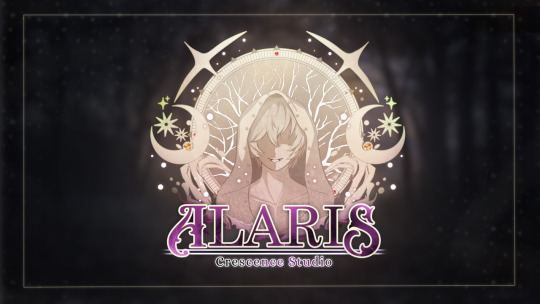
bb i did fckn WORK THIS MONTH U LITERALLY DONT EVEN KNOWWWWWW (but now u will)
MONTHLY DEVLOG TIME!!!
And I have been EAGER FOR THIS ONE. When I say I locked THE FUCK in this month..... OUGGHHHHH.... LET ME SHOW YOU!!!

This month, we had the usual progress on Kuna'a's dev edits (slow but steady) and Etza's line edits. But ON TOP of those edits going on in the background w the editing team, I also had time to go through every single route in the EA build and do the final edits on them. Just to give context, this means I edited 200k words this month, AND BOY WAS IT WORTH IT.
This editing journey included A LOT of things, not just little tweaks to wording here and there. It included polishing the prose, really strengthening character voices, adding more personality branches/choices, and A LOT of reworking for different scenes that I was okay with, but not completely happy with, in the beta versions of the individual routes. On top of reworking scenes, a lot of the routes also got some extra tiny scenes to showcase more cast dynamics, AND because I implemented a shiny new communicator system (which I'll talk about later), there's a lot more messaging conversations going on that I think add a lot more fun and character to your interactions with different LIs.

sneak peek of a new chat convo as an example
I'm really, really, really happy with the writing of the routes now. The characters feel stronger, scenes feel more organic and natural, and the pacing feels much more intentional. And overall the routes just feel a lot more fun!! While I don't think the writing was bad, by any means, before, I do think it's a lot stronger and cohesive now!
I was also able to calculate word counts across routes within the game script, using a Lint feature by another dev. It was a lifesaver because Google Docs gave me just an estimate, but by calculating the word counts within Ren'Py, I have a more accurate word count across the routes. Using this, I adjusted different routes so that the word count is much more even and there's no one route that feels significantly longer than another!

If you think I was making cracked progress on writing, ehehehhee.......................... WAIT UNTIL I TELL YOU ABOUT THIS!!!!
First art accomplishment: I finished THREE sprites for the game!!! (so I only have TWO left now!!!!). I'll showcase one here since I've featured them before, actually. A long, long time ago for those who were here during the Kickstarter ages.

everyone, meet KILUM
Kilum was a stretch goal to have their own route. Unfortunately (for you, but fortunately for me LMAOOOO), we didn't meet that stretch goal. You might remember they look a bit different from the original concept art, and that's because I reworked their color palette after finishing the rest of the Dusk Court's characters so that side of the cast looked a little more cohesive. I'm in love with their design (thanks to bestie @/saffein-e as always), and I hope you're excited to meet them in game! They are certainly A Character!
The other two sprites I finished were actually our two queens HEEH. You will not be meeting them, sorry! Guess you'll have to wait for EA to drop \o/ Anyways, I was really nervous about finishing the sprites in time for the EA build since I had 5 sprites to make, and before this month I had only finished 2 sprites in the span of like 4 years aofsdjaiosjdfaiojsdfioajsdf. So I'm really proud of myself for the sprite progress this month (I always hate making sprites)!




sneak peek feat. eyes. my beautiful children....
We also made CG progress. A LOT of CG progress HEHEHE. Before this month, I had only finished about 26 CGs and that was over the course of like 2 years. That being said, that was while balancing coding beta routes, writing routes, editing, and whatever else I had going on. Now, because I'm locked in on art progress, we have.... *drumroll please*....... 38 CGS FINISHED!!! And that is actually ALL of the ones we need to have done for the EA build!!! So this month, on top of sprite and editing progress, I also finished 12 CGs YEEEAAAAAAAAAA.

Finally, I made some headway on other things this month: one of the biggest being a revamp of the communicator.
my children..... stop fighting....
Big thank you to (@/robobarbie and @/windchimesgames) for the messaging system asset HEHE. now in the game, you will be able to have separate chats for each character and group chats!! I'm still ironing out some kinks with the system and figuring out how to best implement it in the game, but for now, here's a sneak peek of what it's looking like!!!
We also have finally reached a point where we can move forward with voice acting in the game!!! I'll be preparing the lines to send out to the VAs over the next couple of days, but it's so exciting to reach this point since VA is usually what i associate with the Final Stages of production.

I've played a couple of games recently but honestly, so much of my time has been dedicated to Alaris that I haven't had time to do anything like fanart. It's been an ALARIS MONTH BABY!!!
CGs and sprites were the biggest things that I was worried about finishing on time, and given the amount of progress I made on them this month, I think we're in really good shape for EA release!!!
All that's really left for me to do with both editing and like 85% of the art assets out of the way are to finish up the last two character sprites, flesh out the sprite expressions and code those in, and VA! After that, it'll be cleaning for bugs and polishing, so I'm extremely ecstatic over EA progress this past month and hope you all are excited to have it in your hands Very Soon! ^^
Until next time, hopefully I'll bring more exciting news then. Stay cool, especially for those getting hit by the heat waves and general summer heat! <3
60 notes
·
View notes
Note
Hey do you want to make a post going more in-depth about the similarities/differences between the Grand Inquisitor's and Barriss's Inquisifits and what can be extrapolated from that thematically (you know you do) (this is bait)
well :) if you INSIST
let's start off by briefly establishing the relationship between these two (or more appropriately one lack thereof): the grand inquisitor is implied, and confirmed by word-of-god, to be one of the temple guards present during the temple bombing trial, an event which aided in his descent to the dark side. barriss's speech spoke to doubts he already harbored about the order, and her own criticisms of the order confirmed a very particular bias of his about the jedi, one antithetical to the intention of barriss's speech which spoke to a collective disregard for the tenants of jedi order, namely that "fighting for dark-side" had warped the core of their belief system. we've been shown that every one of the grand inquisitor's choices has been made in selfishness, not selflessness. his many resentments and grievances are rooted in personal dissatisfaction and inadequacy with himself, that the jedi order did not balm his hurt is what led to his ultimate repudiation of it. barriss's resentments and grievances are rooted in a deep love for the jedi order that raised, loved, and respected her. they both felt betrayed by the order's misrepresentation of itself, but the grand inquisitor wrongly attributed barriss's feelings of betrayal to his.
now with that groundwork laid, let's talk about the threads! working top-down: the moment barriss defeats dante, her inquisitor helmet is presented to her. it was forged for her before she landed the killing blow. she had no say in its creation. the grand inquisitor is this coven's proud leader; he is responsible for his flock and fortress, and he chose this for her.



a replica, a replicated lapse in self-indulgence, a moment in time where barriss lets her darker impulses, her anger and her hatred, have their say. its design is slightly adjusted to better fit barriss and the inquisitorius' aesthetic, and in there is the implication she is wanted by this empire, she is an asset to this same regime she warned the republic of. we know she regrets the acts of violence she committed under duress as evidenced by both the remorseful expression she shoots ahsoka and by this deleted scene where she explicitly apologizes to her. but the grand inquisitor does not want her moving past this moment. it's a deep well of emotional turmoil that the dark side is eager to drink from. he wants her stewing in it, and 'it' taking the shape of a mode of sensory deprivation is a very happy coincidence! the dark side is at once a state of stasis and parasitism; it successfully feeds off of isolation and hyperfixation, oftentimes from a particularly traumatic event. barriss is forced to become the face of the darkest, most regrettable moment in her life, one where she becomes the betrayer. it reopens wounds which remind her she can operate as both aggressor and aggrieved. it strips her of a voice, modifies her speech, while also working as effective blinkers (blinders/tacks like those used on animals to limit their discernment). the former perpetually-masked temple guard is well acquainted with this hell and assuming the role of traitor! we'll get into his projection in a moment.
after barriss is given her 'gift', we hard cut to her now in full regalia. it's very in medias res; she seems to be in conversation with the grand inquisitor before the rest of the inquisitorius' fledgling brothers and sisters enter the scene. whatever might have been said is left up to our imagination, but judging by both of their expressions, i imagine it was a threat veiled in niceties, much like her 'gift'.

to understand how the grand inquisitor implements fashion mirroring (projection by any other name!) here, you should first have a keen familiarity with the visual language of the inquisitorius' aesthetic sensibilities so to properly pick apart what differentiates barriss's uniform from the rest of the herd's. unifying elements of inquisitors' uniforms are the use of black, grays, and reds, as well as a liberal application of plate-adjacent armour, and some ribbing which likely allows for better mobility.


here we have mommy dearest doing his capital best to suit up his mini-she. most notable are the silhouette's pauldrons and the piece of armour that is something between chest plate and gorget (his gorget has been readapted to be more pronounced/realistic since its inception in rebels and appearance in owk). minor details like the boots and imitation vambraces are also of note, but what i prefer to focus on is the how and why. there is a deliberate likeness, but it's as if hers had its edges sanded down. making her appear less threatening invites predation. it's not enough that she has proven herself capable of murdering her competition, she must remain in a state of hypervigilance around her brothers and sisters. this parasite has a varied palate! fear is a nice little amouse-bouche to rage. the grand inquisitor wants her skills in the dark-side ever-honed and improved upon if she's to be a testament to not just his teachings, but him. see, barriss does not exist to him as a person. since the trial, she has existed conceptually and amorphously to him as an extension of himself and his own issues with the order, but they do not share the same sentiments regarding the order's issues. their dynamic, in truth, more closely resembles that of a narcissistic parent and their child. the child apprentice exists simultaneously to placate his wounded ego, and to fill a void left by (self-imposed) loneliness. i find it a very appropriate representation of this brand of narcissism, to have their authentic relationship be expressed through the medium of costume; it's external, but rarely superficial, it's an assignment, and it's imposed, but unveils so much about both characters' true natures.
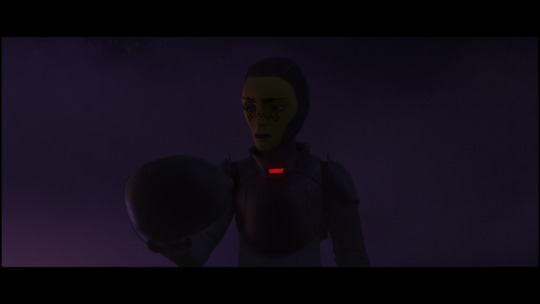

91 notes
·
View notes
Text
Progress Checkup! (Jan. 2025) | Scratchin' Melodii Devlog
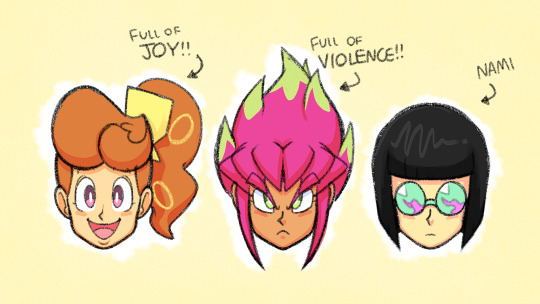
Hey guys! Time for another progress checkup; This is actually the first one of the new year! I hope you were all able to enjoy the holidays. I took a bit of a break from working on most stuff last month and have been getting back on things this month. First, I wanna thank everyone who's wishlisted Scratchin' Melodii on Steam! So far, the game's gotten over 17,000 wishlists! Thanks so much for the support!
In the previous devlog, I mentioned some changes to the rhythm system. In the Dragon Funk preview, you can see the new rhythm system and character icons I mentioned in the previous devlog! Actually, let's unpack some of the new things you're seeing in action there:
Hold Notes This is the first song in the game to include hold-notes! They mostly work the same as they would in any other rhythm game. However, since this game has an emphasis on self expression, moving the control stick during these will let you tune the note's pitch-bend for extra expression points! I showed that off in a post here. As for Pow Notes, I've been working on a way to let the player get expression points from these too! I'd like for most of the special notes like these to be not just a gimmick, but a tool that the player can use to their advantage.
Quadruple Lines Yep! The first blue line in this one is extra long and has 4 rows! Fun fact actually, I had to implement this feature after I realized that part of the song was too long to fit in just two rows. It was pretty difficult to figure out both how to do it and how to execute it in a way that doesn't feel too jarring, but I'm pretty satisfied with the results! In fact, barely anyone's even noticed it; I guess that's just how natural it feels! Not sure how much more often I'll be having lines longer than two rows, but it's great that I have the option now.
AutoPlay You might also notice that the player inputs are perfectly timed... TOO perfect... that's because I've developed an autoplay feature for the game! At the moment, it's mostly for debugging and stuff, but if all goes according to plan, AutoPlay Mode and Replays should hopefully be available to players as well in some form when the game comes out!
"Next" Indicator & Other UI Related QoL Some of the top things players said they had trouble with in the demo were related to being prepared for the next line. So, if you look at the right-end of the rhythm bars, you'll see a little tab that shows the color and amount of rows the next line will have! Also, now each line's suggested notes can be seen before the rival performs them. This did take some thought, as I actually kinda still liked the idea of it appearing as if the characters were making it up on the spot, but to put game design first, it makes more sense to have it displayed as soon as possible so the player has more time to react and prepare. This also opens up more possibilities for future mechanics, so in the long run, I think I've made the best choice here.
Now, let's get into what I've been and/or will be working on that you haven't seen yet!
Act 2's Boss The music for the Act 2 Boss is nearly complete! I'll likely be starting to animate it pretty soon. This song is the longest one I've done so far, clocking at a duration of a little over 3 minutes long!
More Animation Updates for Stir & Mix At this point, I've done even more cleanups on the sequence you saw in the last devlog and I've finished animating the "I wanna" scene of the song, which will probably have the most changes out of any other scene in the song. When I first animated Stir & Mix, I didn't quite have the time or skills to do everything I really wanted to do with it. That scene in particular I felt was WAY too stiff and boring, especially compared to the more dynamic and fluid scenes that appear in some of the other the stages now. I'd say I'm about halfway done retouching all the animations for this one!
Refined Model Sheets I don't talk about these very often, but sometime around 2023 I started using model/reference sheets for the characters. (I might show them off someday, but for now they're staying private!) Before this point, the designs are pretty inconsistent from shot to shot, so this helped a lot with that. Recently, I've done some revisions I'm really pleased with. Their designs are finally becoming... well, final! I'll be reworking the affected characters' hub world sprites at some point to reflect these changes.
Slight Reworks for some Act 1 Songs On the sound side, Stir & Mix's vocals have been reworked again! As I've mentioned in the previous devlog, 2cada's tuning style and techniques have evolved a bit since we first started working together, so we thought it'd be fun to go back and incorporate some of that into it. We'll also probably be reworking the structure of Nami's song a little bit at some point just to make it a feel a bit more solid, which may require a new line or two from her voice actor, Meggie-Elise! So funnily enough, it seems some of the songs will have end up having TWO unused beta versions after this.
Also, a quick PSA: Please note that beta versions of content will NOT be included in the full game. I've heard people ask for them to be "brought back" or toggleable, but in my situation something like that is both easier said than done and I also just... don't want to LOL. With as many directions I can take this game, I know I can't satisfy everyone, but I can make a game that satisfies me, so I'm aiming for that! And hey, maybe other people will like it too.
I think that's all I wanna talk about for now! Thanks so much for reading. It can be a bit of a daunting task to write these at times, but I'm glad to keep you up to date on the project when I can.
-LJ
134 notes
·
View notes
Text
Fields of Mistria fankids #1: March
I’m not sure if Fields of Mistria is planning to implement a kids system, but I got inspired by Harvest Moon and Fire Emblem Children Mechanics and wanted to try my hand at designing looks for the kids of the bachelors and bachelorettes!
Anyway, let’s talk about March’s child! (My partner started calling her April so I might stick with that lol)
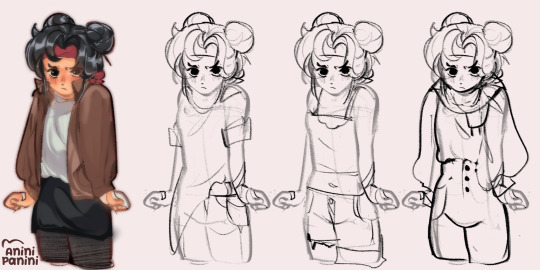
Listen, I think March would be a girl dad… see my vision
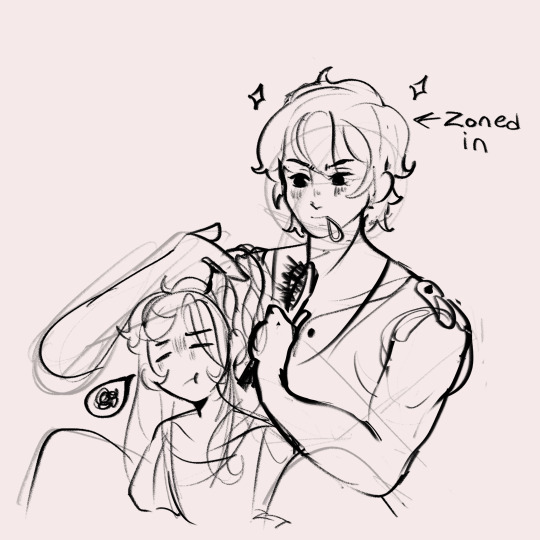
HCs and more art under the cut🤭
She ends up with a terrible attitude problem because her dad spoils her rotten
Not like, all the time, she’s just easy to explode
To him she’s an angel though, she can’t say no to her dad and he can’t say no to her either
Inherits the creativity and the passion to just, make stuff. Already shaping and molding clay or coloring the walls (to her parents dismay) or anything else she can get her hands on
Inherits her dad’s natural hair, she spent her childhood wondering when the red hair would grow in
She’s next in line to take over the family’s blacksmithing business, the responsibility stresses her out
Still, she diligently pays attention to her father’s lessons, but she’d rather ACTUALLY be doing the smithing instead of just observing
The last (and first) time he let her work the forge, she hurt herself really badly. He won’t let her touch it again until he determines she’s ready…
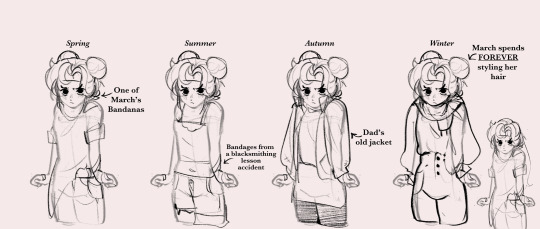
[Seasonal Wardrobe, Spring -> Summer -> Autumn -> Winter + hair down]
I don’t think her wardrobe would be girly or extravagant, but practical with some hand-me-down pieces (not that March doesn’t buy her stuff, I think she just likes wearing her dad’s old jackets and stuff and feeling cool like him)
Also, she can work on her arts and crafts better in simpler clothing
Also her dad definitely spends forever brushing and styling her hair because, as per usual, he feels it just has to be perfect. Getting worked up is his favorite hobby after all
________________


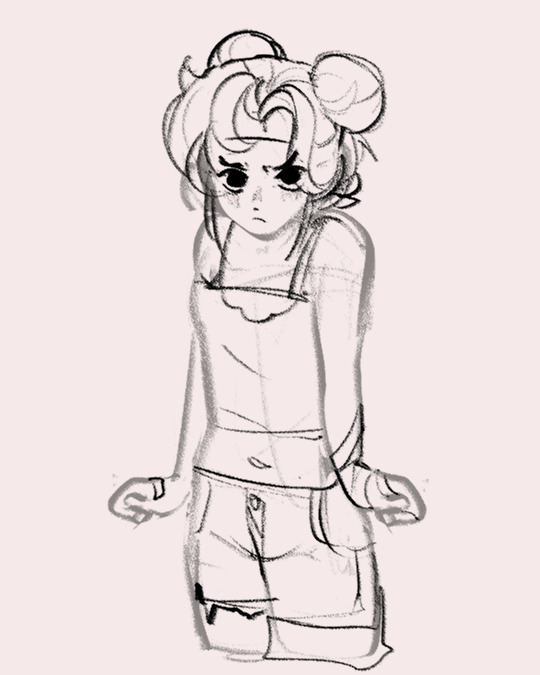
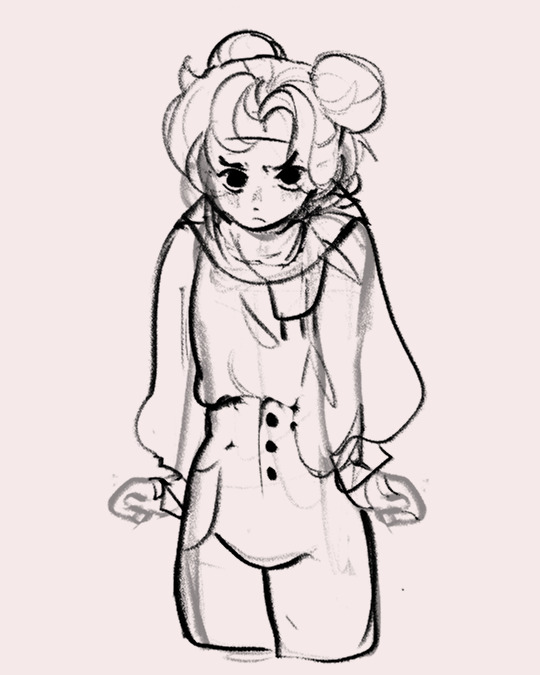
#honestly if FoM adds children I just hope they inherit something from the parents 😓#fields of mistria#fields of mistria fanart#march#fields of mistria march#march fields of mistria#fom#fom march#digital art#my art#artists on tumblr#character design#also im actually still deciding if ill design more fankids because currently im mostly fixated on March😭#my artwork#cute art#march fom#original character#fanchild#fields of mistria headcanons#fields of mistria HCs#headcanon#HCs#fom headcanon#fom fanart#fom fankids#fom oc#oc#oc art
165 notes
·
View notes